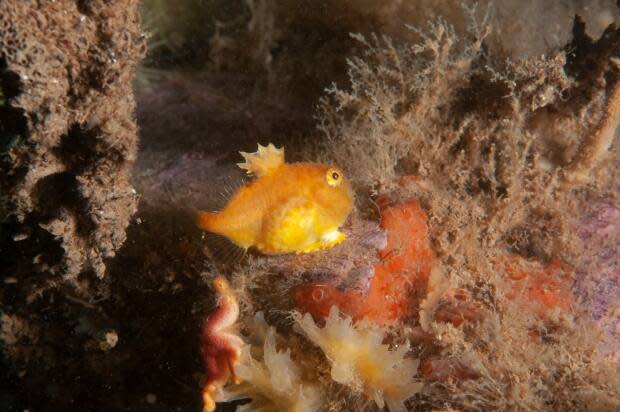Dive deep into the Bay of Fundy without leaving home

If you have ever wanted to see what lives under the dark waters of the Bay of Fundy — without the risk of unknown plant matter brushing against your legs — you're in luck.
Dive Deeper, a virtual museum exhibit on the Passamaquoddy region of the Bay of Fundy launched this week.
The website, presented by the Huntsman Marine Science Centre, lets you take a deep dive into the flora and fauna that live above and below the bay's depths from the comfort of home.
Through a mix of the latest technologies in marine mapping and underwater photography, users can explore 3D maps and 360-degree videos of six areas of Passamaquoddy Bay.

Meanwhile, photos and videos of underwater marine life get you up close without having to dive.
From a lumpfish giving the underwater cameraman side-eye as it swims away, to forests of sea potatoes bobbing in the currents, there is a lot to explore.
Claire Goodwin is a research scientist with the Huntsman Marine Science Centre and the curator of the Atlantic Reference Centre Museum.
She was also one of the divers who dove and brought the underwater world to the screen.

"I mean, this region is amazing.," said Goodwin, who moved to New Brunswick six years ago from England. "It's just got such diversity, so many different sites."
The region they explore is inside an invisible line from Point Lepreau to the corner of Grand Manan, Goodwin told Information Morning on Wednesday.
One of her favourite dives in the area is Deer Island Point, which is near the "Old Sow" whirlpool and not for novice divers.
There were sometimes only half-hour windows where they could dive as the powerful tides eased temporarily. But when they did slack, divers were rewarded with bedrock teeming with life.
"People seem to believe that we only get colourful marine life in tropical areas," said Goodwin. "But actually … we have beautiful, colourful marine life all around this area."
The underwater videos take viewers anywhere from the den of an Atlantic wolffish, chowing down on a horse mussel — shell and all — to following a lobster on his travels across the seabed.
Chandler Stairs is a graduate student in biology at the University of New Brunswick, and part of a research lab studying the role of the Atlantic wolffish in Passamaquoddy Bay.
The wolffish can be scary at first glance — a large-headed fish with protruding teeth that dwells in dens.
Stairs said they're an apex predator, but they're known to be docile toward divers.
Stairs was not involved directly with the Dive Deeper project, but her research team is mentioned by it.

She was excited about the project, though, saying a challenge with presenting marine research and biodiversity information to the public is often the lack of a platform.
"Their website is phenomenal in the way that they have it set up," said Stairs. "It's very accessible and nice for anyone that's just interested in learning more about the bay."
Goodwin said the dual purposes of the project were to inspire people to learn more about the intricate ecosystems and to encourage young people to consider potential careers in a variety of fields within marine sciences.
"That's what we're trying to do through the website — just raise awareness about how amazing the habitats we do have are, and the species we have here are, and hopefully engage people in wanting to protect them for future generations," she said.

Peter Lawton is a research scientist with Fisheries and Oceans Canada in Saint Andrews, and one of the researchers interviewed as part of a series on marine science professions and their technology.
Lawton said he was particularly impressed by the lesson materials available for teachers on Dive Deeper, and the variety of marine species included.
"I think as an educational resource it's tremendous," said Lawton. "I do think it will give people a very different perspective on the area."
Lighting the deep
The Bay of Fundy is cold and dark, and it took teamwork to light and record the site's underwater footage.
According to Goodwin, the 360-degree videos required a special film team led by Chris Harvey Clark from Dalhousie University.
Not only did they need the right camera equipment, but multiple divers carrying enormous lights were required, which meant they had at least a three-person dive team.

Goodwin, who dives year-round, said she was never truly scared while underwater in the Bay of Fundy — though she hasn't run into a great white shark yet and admitted she isn't sure how she would feel about that.
"We have had some instances where we've come up and the currents picked up quite quickly," said Goodwin. "When we're on the safety stop, we're being pushed around by the current so that's a bit exhilarating, really."
The project received funding from Digital Museums Canada in 2017 and it took nearly six years to complete. Dive Deeper is also a bilingual website with video descriptions and 2D options for accessibility.


